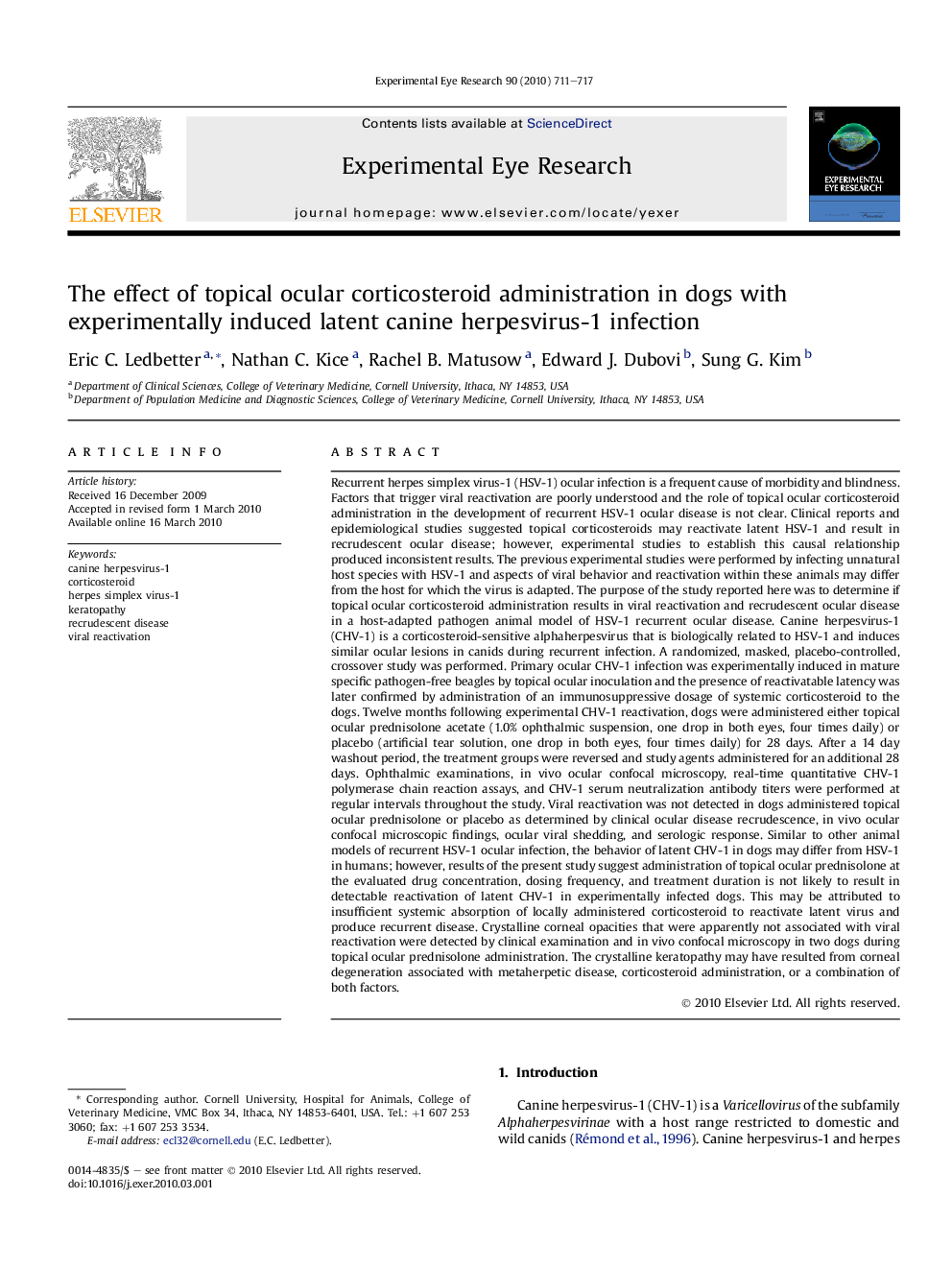| کد مقاله | کد نشریه | سال انتشار | مقاله انگلیسی | نسخه تمام متن |
|---|---|---|---|---|
| 4011560 | 1602625 | 2010 | 7 صفحه PDF | دانلود رایگان |

Recurrent herpes simplex virus-1 (HSV-1) ocular infection is a frequent cause of morbidity and blindness. Factors that trigger viral reactivation are poorly understood and the role of topical ocular corticosteroid administration in the development of recurrent HSV-1 ocular disease is not clear. Clinical reports and epidemiological studies suggested topical corticosteroids may reactivate latent HSV-1 and result in recrudescent ocular disease; however, experimental studies to establish this causal relationship produced inconsistent results. The previous experimental studies were performed by infecting unnatural host species with HSV-1 and aspects of viral behavior and reactivation within these animals may differ from the host for which the virus is adapted. The purpose of the study reported here was to determine if topical ocular corticosteroid administration results in viral reactivation and recrudescent ocular disease in a host-adapted pathogen animal model of HSV-1 recurrent ocular disease. Canine herpesvirus-1 (CHV-1) is a corticosteroid-sensitive alphaherpesvirus that is biologically related to HSV-1 and induces similar ocular lesions in canids during recurrent infection. A randomized, masked, placebo-controlled, crossover study was performed. Primary ocular CHV-1 infection was experimentally induced in mature specific pathogen-free beagles by topical ocular inoculation and the presence of reactivatable latency was later confirmed by administration of an immunosuppressive dosage of systemic corticosteroid to the dogs. Twelve months following experimental CHV-1 reactivation, dogs were administered either topical ocular prednisolone acetate (1.0% ophthalmic suspension, one drop in both eyes, four times daily) or placebo (artificial tear solution, one drop in both eyes, four times daily) for 28 days. After a 14 day washout period, the treatment groups were reversed and study agents administered for an additional 28 days. Ophthalmic examinations, in vivo ocular confocal microscopy, real-time quantitative CHV-1 polymerase chain reaction assays, and CHV-1 serum neutralization antibody titers were performed at regular intervals throughout the study. Viral reactivation was not detected in dogs administered topical ocular prednisolone or placebo as determined by clinical ocular disease recrudescence, in vivo ocular confocal microscopic findings, ocular viral shedding, and serologic response. Similar to other animal models of recurrent HSV-1 ocular infection, the behavior of latent CHV-1 in dogs may differ from HSV-1 in humans; however, results of the present study suggest administration of topical ocular prednisolone at the evaluated drug concentration, dosing frequency, and treatment duration is not likely to result in detectable reactivation of latent CHV-1 in experimentally infected dogs. This may be attributed to insufficient systemic absorption of locally administered corticosteroid to reactivate latent virus and produce recurrent disease. Crystalline corneal opacities that were apparently not associated with viral reactivation were detected by clinical examination and in vivo confocal microscopy in two dogs during topical ocular prednisolone administration. The crystalline keratopathy may have resulted from corneal degeneration associated with metaherpetic disease, corticosteroid administration, or a combination of both factors.
Journal: Experimental Eye Research - Volume 90, Issue 6, June 2010, Pages 711–717